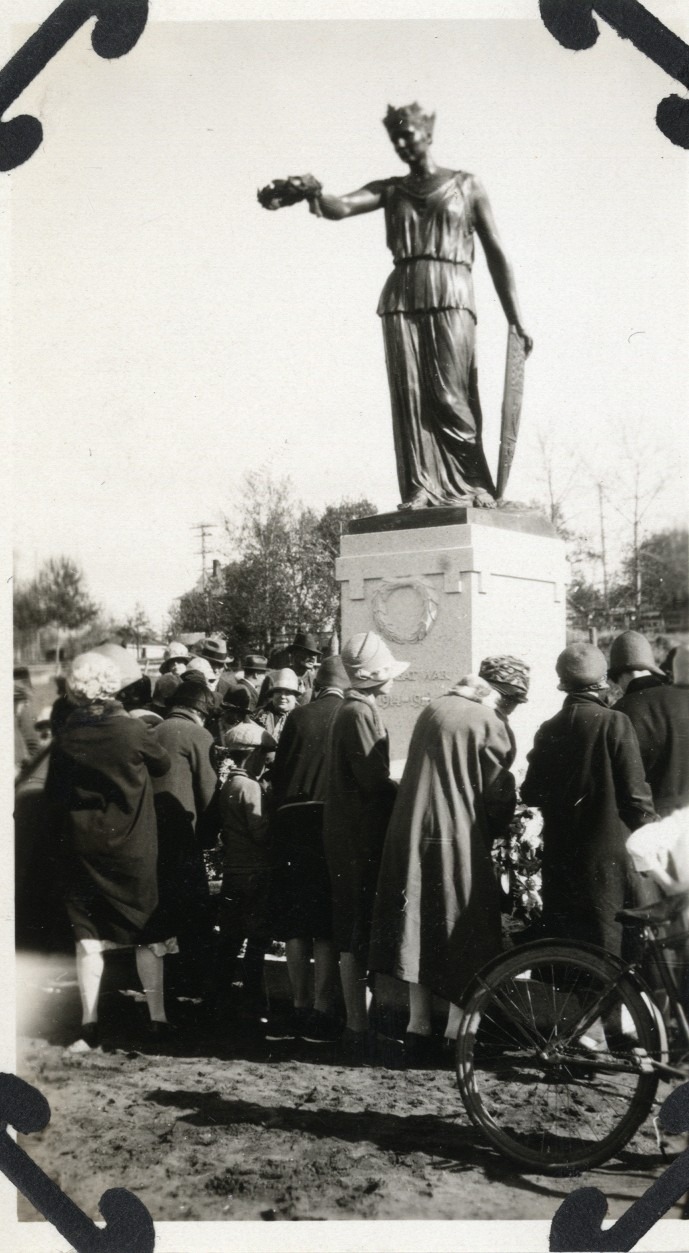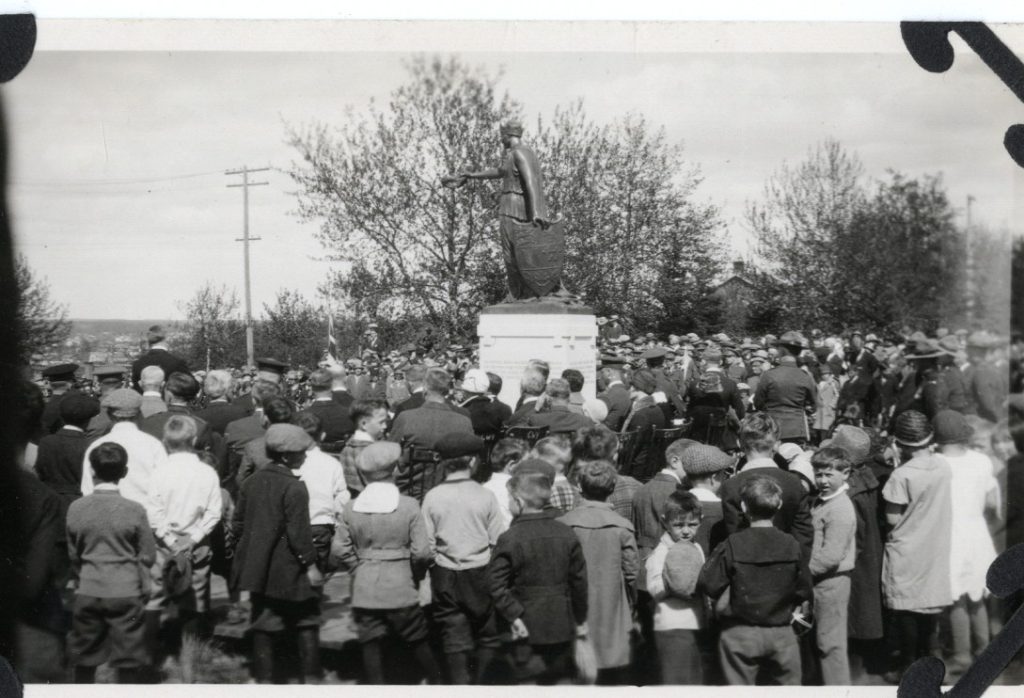
The Cenotaph which sits in front of the Court of King’s Bench building, at the top of the Central Avenue viaduct, was unveiled on Friday, the 3rd of June, 1927 in front of a large and patriotic crowd of local citizens.
Nearly nine years had passed since the Armistice had been signed to end the Great War, and there were those who felt that the unveiling of the cenotaph, and the commemoration of those who had made the supreme sacrifice, was long over due. The long wait, however, had its compensations as the monument erected was in every way a worthy memorial, serving to honour our war dead while at the same time as it breathes the hopes and aspirations of the living.
Unique in its design, it is believed that the War Memorial is the first attempt to portray in sculpture the spirit of a Canadian nationality. Standing over fourteen feet tall (4.3 metres), and costing in the neighbourhood of $10,000 (about $170,000 in today’s terms), it was designed and sculpted by Mrs. Hilliard Taylor of Winnipeg.
Amongst the many messages which the Memorial bears is an expression of our thanks to the loved ones who were left behind by those who answered the call and paid the supreme price. To our war veterans, it prompts a recollection of the warm hand clasp, the real friendship of those who now sleep peacefully in graves, both known and unknown, in foreign lands. To those who remain, it issues a call to stand by the principles for which the war dead sacrificed their all, and asks for a continued pledge that these principles will be ever maintained. And to we the public, it is a reminder of our responsibility to the widowed, the fatherless, and those disabled, whether physically, mentally, or emotionally, as a result of their service to our nation.
Unveiled by Saskatchewan’s Lieutenant-Governor, the Honourable Henry Newlands, the monument was blessed by the Reverend Canon Walter Burd, canon residentiary of St. Alban’s Cathedral, after which the Honourable James Gardiner, Premier of Saskatchewan addressed those gathered around the Cenotaph. And what a crowd was gathered around it. Amongst the dignitaries were women widowed, children who had lost their fathers, and veterans who had lost their compatriots.

Elementary school students, both public and separate, had marched in the parade, carrying banners bearing the names of local men who were lost in battle. A band composed of Boys Scouts, as well as the City Band under the direction of Bandmaster A.F. Wilde, and the bugle band of the Prince Albert Volunteers stirred the crowd with the strains of martial music, as well as “The Last Post”. Mounted members of the Royal Canadian Mounted Police participated, as well as members of the Saskatchewan Provincial Police, and members of the Prince Albert City Police. Members of the local church choirs, ably directed by C.J. Ferguson, joined together to lead the singing of “O God Our Help in Ages Past” as well as “O Canada” and “God Save the King”.
The afternoon was chaired by Dr. D.P. Miller, acting on behalf of the Honourable T.C. Davis (the Memorial Association’s chairman), and events were directed by Hal Fraser, the secretary of the Association. It must have been a time of great pleasure for the members of the local Rotary Club, to see the unveiling ceremony bring to a conclusion an effort which they had initiated four years previously.
In his address, Premier Gardiner commented that the returned men who fought for the principles of freedom, truth, and justice are the guarantee to Canada that these ideals will be upheld. This followed the comments made by the Lieutenant-Governor when he placed a wreath on the Memorial on behalf of His Majesty King George the Fifth. His Honour made feeling reference to his lengthy associations with the City and the pleasure which it gave him to be present and take an active part in the unveiling ceremony.
When it came time for the unveiling of the Memorial, the only glitch in the afternoon occurred. The ropes had become tangled and, when pulled by the Lieutenant-Governor, jammed. Edward Paine Jr., a member of the bugle corps, mounted a ladder, untangled the ropes, and was actually the individual who unveiled the monument.
After the sounding of “The Last Post”, Dr. Miller, on behalf of the Memorial Association, gave the monument over to the custody of the City. Mayor S.J.A. Branion accepted on behalf of the citizens. Mayor Branion thanked those who had offered their lives in the service of their country, and congratulated the members of the Memorial Association for their work, and for their acceptance of the design and work of the sculpture. He indicated how appropriate it was for the Memorial to be unveiled during the Golden Jubilee of the Nation of Canada.
The placement of a number of wreaths, from associations and from private individuals, followed the acceptance of the Memorial by the Mayor on behalf of the citizens of Prince Albert. The Reverend J.R. Graham pronounced a solemn benediction, after which those gathered closed the event by singing “God Save the King”.
Nothing did more to establish Canada as a nation than the part which its armed forces played in the Great War. In the forces’ ranks were men who had come from numerous nations, men who followed different creeds, and whose political beliefs were varied. Yet they lived together in harmony, and fought together in a concentrated effort. Minor distinctions were forgotten in pursuit of the greater objective. The greatest lesson of the war to Canadians was the value of tolerance.
It is this message of tolerance that the Prince Albert War Memorial, perhaps one of the finest pieces of art in Western Canada, broadcasts nation-wide. As we remember all those who have served our country on the battlefields throughout the world, let us focus on the message of our Cenotaph.
As a tribute to our veterans, the Prince Albert Historical Museum, 10 – River Street East, will be open on Saturday, November 11th, from 1:00 p.m. to 4:00 p.m. Admission is free. A short programme highlighting the history of cadet programmes in Prince Albert will begin at 2:00 p.m. All are welcome.
fgpayton@sasktel.net

